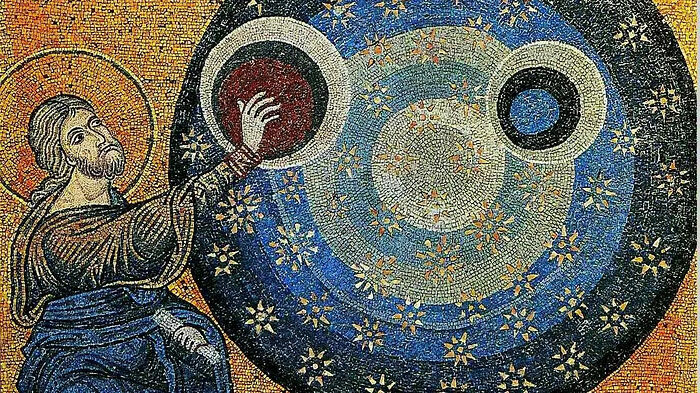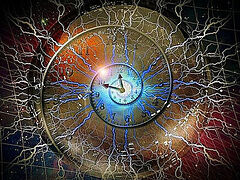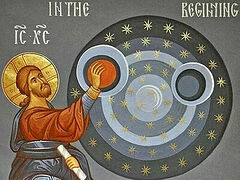Part I. The Concept of Time in Science
There are some things that God has kept secret from us until we are able to understand them. Prophet Daniel was told, But thou, O Daniel, shut up the words, and seal the book, even to the time of the end: many shall run to and fro, and knowledge shall be increased” (Dan, 12:4). What would have happened, for example, if the sacred writers had said that the Earth was travelling through space? The religious debates would have continued for several thousand years, up to Newton’s time, with the opponents of Holy Scripture constantly questioning this statement’s veracity. [It would have been difficult for people to believe that Earth was moving because] whenever the people of the past were travelling—whether on foot, on animals (horses, camels, elephants), chariots or ships—they always felt the motion. When Copernicus, and later Galileo, figured out that Earth was rotating around the sun, both religious leaders and secular scientists declared this teaching to be untenable.
5. Days of Creation
The situation with time is similar. We are already convinced that the nature of time is inexplicable by science and that this concept is beyond the understanding of the modern man. The word “yom” in the Bible can mean both a regular day and an indefinite period of time. That is why Christians often argue about the interpretation of the days of creation in the Book of Genesis. Many theologians still believe that this word means a 24-hour day because in most of the holy texts it is used to refer to a certain day of the week. However, there is a different point of view. Can the Hebrew word “yom” in the story of the creation of the world mean something other than a specific period of time? In the Book of Job (20:28), “yom” refers to the time of God’s wrath, and in Psalms (20:1) it is used in the expression “day of trouble”. It is also possible that in 2 Chron. 21:19, Hos. 6:2, Gen. 2:4 and some other books, this word is used to refer to lengthy periods of time.
Light was created on the first day of creation: And God said, Let there be light: and there was light (Gen. 1:3). Some think that this light was emanating from a certain singular source of light (that doesn’t exist anymore?), and as Earth was rotating on its axis, day and night were alternating within a 24-hour period. The words “And the evening and the morning” imply that there was a sunrise and a sunset. But if so, it would mean that God was present in a certain specific point on the surface of Earth when He was creating, which contradicts the contextual notion that the planet was created as a whole. Therefore, it is more likely that the light that shone upon the earth and heavens that day was coming from all directions. The so-called “cosmic microwave background” (CMB) is possibly a remnant of that light.
As the universe expanded, the CMB gradually grew weaker, so the sun, the moon and the stars were created on the fourth day of creation, so that people could tell the day from the night, and let them be for signs, and for seasons, and for days, and years (Gen. 1:14). Although the word “night” is used in the beginning of the story (Gen. 1:5), it obviously refers to something that would appear later, for there is no darkness for God: If I say, Surely the darkness shall cover me; even the night shall be light about me. Yea, the darkness hideth not from thee; but the night shineth as the day: the darkness and the light are both alike to thee (Ps. 139, 11–12). In this case, the period from “night to day” (i.e. “the night of creation”) can only be understood as a period during which God suspended His activity. It should be noted that significant time is needed for the stars to become visible in the sky. The naked eye can discern about two thousand stars that are located at various distances from Earth, but their light would have to travel anywhere from four (in case of Proxima Centauri) to several thousand years (in case of the most remote stars) before the first people could enjoy their beauty.
At the beginning of the sixth day of creation, God created land animals. Then He created Adam in His image and likeness to rule over all creation and cultivate and maintain the Garden of Eden. Charles Thaxton and Nancy Pearcey wrote the following in this regard.
“From the Book of Genesis we learn that God brought the animals to Adam to name them (Gen. 2:19-20). In Ancient Hebrew, “to name something” means “to acquire power over something”, i.e. this Biblical text refers to man’s power over nature. Besides, according to the Hebrew way of thinking, the name of a subject must express its nature. Hence, to give names to animals Adam had to have studied them meticulously to determine what they were. This task would have required detailed observation, description and classification.”1
Therefore, Adam had to have lived for a certain time with the animals so that he could learn about them and choose appropriate names for them. Assuming that several thousands of land animals had been named (including, perhaps, those taken by Noah in his ark), such a task would have required considerable amount of time and intellectual effort.2 In the time following, Adam acquainted himself with them for a period before he was sure that none of the animals could be a suitable helper for him. Then God caused a sleep to fall upon Adam and made Eve out of his rib, and Adam fell in love with her. This completed the act of creation. All of this couldn’t have been completed within twelve hours of daylight!
Nothing is said about the completion of the seventh, final day of creation (evening or morning are not mentioned); that is, it is supposed to be endless. In this case, the “sabbath” blessed and hallowed by God was that sinless state of physical and spiritual order, harmony and peace of the world built by the Creator. According to the fourth commandment, this seven-day week was the blueprint and example that the Israelites had to follow:
Remember the sabbath day, to keep it holy. Six days shalt thou labour, and do all thy work… For in six days the Lord made heaven and earth, the sea, and all that in them is, and rested the seventh day: wherefore the Lord blessed the sabbath day, and hallowed it (Exod., 20:8-11).3
As follows from the above, the days on Earth are a reflection of “the days of creation”, however there’s no reason to assert that the former and the latter have the same length. Naturally, there are other Biblical arguments supporting this conclusion, but we will present only the most important ones.
6. How the Church Fathers interpret the days of creation in the Book of Genesis
From the Christian standpoint, God created the universe ex nihilo, but He Himself is above matter, space and time. The moment of the creation of the world is also the origin of time (which is fully consistent with the theory of relativity). As St. Augustine noted, “God created not in time but with time”.
God created the universe ex nihilo, but He Himself is above matter, space and time
The Church Fathers also believed that it was impossible to determine how long the days of creation were. Hieromonk Seraphim (Rose) made a comprehensive comment on their interpretation of the Book of Genesis:
“But most Fathers do not say anything at all on the subject: it was not a subject of debate in their times, and it seems not to have occurred to them to insist on projecting the time scale of our fallen world back to the stupendous and miraculous events of those Six Days. Blessed Augustine, I think, sums up well the Patristic attitude when he says, ‘What kind of days these were is very difficult for us to conceive, or even completely impossible; and all the more impossible is it for us to speak of this [City of God, XI, 6].4
Many Christian authors (St. Justin Martyr, St. Irenaeus of Lyon, Clement of Alexandria, St. Cyprian of Carthage and others), while not specifying the duration of the days of creation, thought that it was possible that they coincided with certain periods of human history (each lasting approximately a millennium) up to the end of the world.5
Others, like St. Ephraim the Syrian, believed that the days of creation referred to twenty-four-hour days. However, the vast majority of the church writers never discussed their duration at all. Another noteworthy tendency is that most of them believed that the world was created by sequential but momentary acts of creation.
The world was created by sequential but momentary acts of creation
First God created land: The continents emerged, the mountains rose, the valleys formed, and the outlines of the rivers, seas and oceans were defined. Later, flora and fauna were created in a similar way, including grass, flowers, trees, fish, birds and animals, followed by man, “the image and likeness” of the invisible God.
The holy fathers often say that God’s creation is direct and momentary (i.e. timeless) and that it is His word that brings both the animate and inanimate to life.
St. Basil the Great noted that “Perhaps these words, In the beginning God created, signify the rapid and imperceptible moment of creation. The beginning, in effect, is indivisible and instantaneous. The beginning of the road is not yet the road, and that of the house is not yet the house; so the beginning of time is not yet time and not even the least particle of it... Thus then, if it is said, In the beginning God created, it is to teach us that at the will of God the world arose in less than an instant, and it is to convey this meaning more clearly that other interpreters have said: God made summarily, that is to say, all at once and in a moment.” (Hexameron I:6).
Clement of Alexandria had a similar approach:
“And how could creation take place in time, seeing time was born along with things which exist... That, then, we may be taught that the world was originated, and not suppose that God made it in time, prophecy adds: “These are the generations of the heavens and of the earth when they were created, in the day that the Lord God made the earth and the heavens” (Gen. 2:4). For the expression "when they were created" intimates an indefinite and dateless production.” (Clement of Alexandria, Miscellanies 6:16).
St. Basil the Great makes another exceptionally important comment: In the beginning of creation, it was not only nature that was created, but also the laws that governed it. He says that there was no natural need for the waters to flow into the lowest point; such is the law of our world—but at that time God had yet not willed it, so there were no laws either:
“Is it not a law of nature that water flows downwards? Why, then, does Scripture refer this to the fiat of the Creator?... If such is the nature of water, it was supererogatory to command it to gather into one place... To the first question I reply: Since God's command, you know perfectly well the motion of water; you know that it is unsteady and unstable and fails naturally over declivities and into hollow places. But what was its nature before this command made it take its course? You do not know yourself, and you have heard it from no eye-witness” (The Hexaemeron, IV, 2).
Some Church fathers tried to calculate how much time had passed since the beginning of the world. Clement of Alexandria says 5592 (Miscellanies 1, 21), Sextus Julius Africanus 5550 (Chronology, Fragment 1), Hippolytus of Rome under 5500 (Daniel, 2:4), Origen under 10,000 (Contra Celsum, 1:20) and St. Augustine under 5600 (City of God, 12:11).6
In the mid seventeenth century, an Irish bishop, James Ussher, made some calculations based on patriarchs’ lineages and concluded that the world was created in 4004 BC. However, in 1890 prof. William Green from Princeton University, having seriously analyzed the Biblical chronology came to the conclusion that it was not sequential and not uninterrupted.7
Considering all the above and the possibility of many missed lineages, we can only say that according to the Bible, about ten thousand years (or tens of thousands of years at most) passed after the creation and the Fall of man (but not after the creation of the world (!))
7. Is it possible to reconcile Creation of the World with science?
The act of Creation is supernatural, i.e., it is not subject to the laws of nature and does not arise from them, hence none of its aspects can be repeated or fully analyzed by scientists. Nevertheless, recent scientific discoveries of inexplicable traits of time can help us get at least a partial and intuitive idea about what happened during that first miraculous week.
Every direct result of God’s creation appears in its complete form—such as the sun, the moon, the stars, plants, animals, Adam and Eve—but they look like they have a long history. The same goes for many miracles of Jesus—water turned to wine in Cana of Galilee, or the loaves of bread that He fed to several thousands of people, must have gone through the processes of gathering grapes and grinding grains, etc. resulting in the final product.
If the universe was created over a short period of time (or even if it was created instantaneously) as suggested by the Church Fathers, then obviously the light of the faraway galaxies wouldn’t be able to reach us, and we would have to refer to a miracle to explain this phenomenon. (Unlike Hawking and Mlodinov who often use unproven theories without mentioning it, we admit that this is simply our speculation and we won’t be using it when we further discuss the possibility of proving the existence of God). If the rays of light were travelling at an infinite speed, we would be able to observe all galaxies at the same time. However, since the speed of light is finite, we can trace the past of the universe, and soon in all probability we will become witnesses to the moment of Creation itself!
As you recall, Hawking’s “virtual time” implies that “the difference between space and time completely disappears”. When Church fathers say that the creation of the world was instantaneous, from the scientific point of view they reach a fairly similar conclusion (albeit leading to other consequences), specifically stating that time was merged with spatial measurements. Currently, we see a vast universe that according to Clement of Alexandria is the product of undefined and timeless creation. Unlike Hawking’s universe, which is “eternally existing”, this universe has a beginning and an end in time.
Another analogy that can help us illustrate the time aspect in the Bible is the cosmonaut in the orbital station—while the events at the station flow normally, the galactic systems are rotating at a breakneck speed before his eyes. Similarly, unfathomable cosmic eons may equal a single “day of creation” on Earth (for “one day is with the Lord as a thousand years, and a thousand years as one day” [2 Peter, 3:8]).
We always view movement as a function of time. However, as we mentioned earlier, virtual particles can change their positions even if time completely stops. In other words, it is possible that planetary, stellar and galactic systems were created in the course of movement, even if the universe as a whole was created outside of time.
Moreover, radioisotope dating may not even be that reliable. Recently, scientists tried to use radioisotope dating to determine the age of rocks formed as a result of volcanic eruptions in the last few decades. Their results varied from hundreds of thousands to several millions of years. Naturally, this begs the question: If radioisotope dating cannot be used to date the age of the rocks of known age, why should we trust this method when we deal with rocks of unknown age?8
Adam’s Fall affected the nature of the entire universe, resulting in exploding stars, colliding galaxies, etc.
As noted correctly by St. Basil the Great, the laws could have been different when the world was created. In the primordial perfect world, the law of entropy did not create chaos and destruction; instead it maintained order and harmony (or there must have been another balancing law that prevented the disruptive processes). If the second law of thermodynamics were really related to the flow of time, then the changed situation after the Fall (when “the creature was subject to vanity” (Romans, 8:20-21) should have changed the flow of physical processes. Moreover, Adam’s Fall affected not only the nature of Earth, but also, instantaneously, the nature of the entire universe, resulting in exploding stars, colliding galaxies, etc.
Ukrainian nuclear physicist Prof. Vladislav Olkhovsky gave the following answer to the question about the age of the universe (and, consequently, Earth):
“The alpha-active nuclei are subject to the law according to which their decay time may decrease hundreds of thousands of times per every megaelectron-volt. For beta decay, there is another law stating that if an atom does not have an electron shell, the time of decay may decrease from tens of billions of years to only decades. As such, science cannot give a definitive answer to this question”.9
His words are confirmed by two recent discoveries. A group of scientists established that an excessive amount of helium in rock is observed during the radioactive decay of uranium (U238) → helium (He) + lead (Pb206), which indicates that at some point in history nuclear decay differed significantly from the current decay. The scientists arrived at the following conclusion:
“The data and our analysis demonstrate that in a very short period before our time, a nuclear decay that normally would have taken more than a billion of years occurred in a period of approximately 4,000 to 8,000 years.10
Other research indicated that coal and diamond samples dated at hundreds of millions or billions of years old contain (Carbon-14), which can only be explained by the fact that their real age is approximately ten thousand years (or tens of thousands of years at most).11 As we mentioned earlier, these periods are consistent with the time of the Fall.
Soft tissues are found in organic fossils that are estimated to be tens of millions of years old
During the last two decades, soft tissues have been frequently found in organic fossils estimated to be tens of millions of years old. For example, fibrous protein collagen along with blood vessels have been discovered in the remains of a Tyrannosaurus rex dated to be 65 million years old.12 The tests that were subsequently carried out showed that the blood vessels contained the remnants of blood cells with traces of hemoglobin.13 It would be obvious to any biologist that there is no way that these organic substances could have been preserved over such a vast period of time. The same is confirmed by extracting well-preserved DNA from plant fossils in the rocks which are believed to be millions of years old. Considering the speed of decay, it is impossible for DNA to remain intact for more than ten thousand years.14 15
Many theologians and scientists assure us that the Bible and nature are in essence two books that are written by God, and that these books complement rather than contradict each other.
If nature is another “book” wherein God wrote His thoughts, then it should independently confirm whatever is said in the Bible! Unfortunately, the theory of evolution currently dominates, allowing no interpretation of the scientific results that contradict it. Still, we hope that scientists will be more consistent and helpful in opening the door to scientific explanation of the Creation of the world.16




